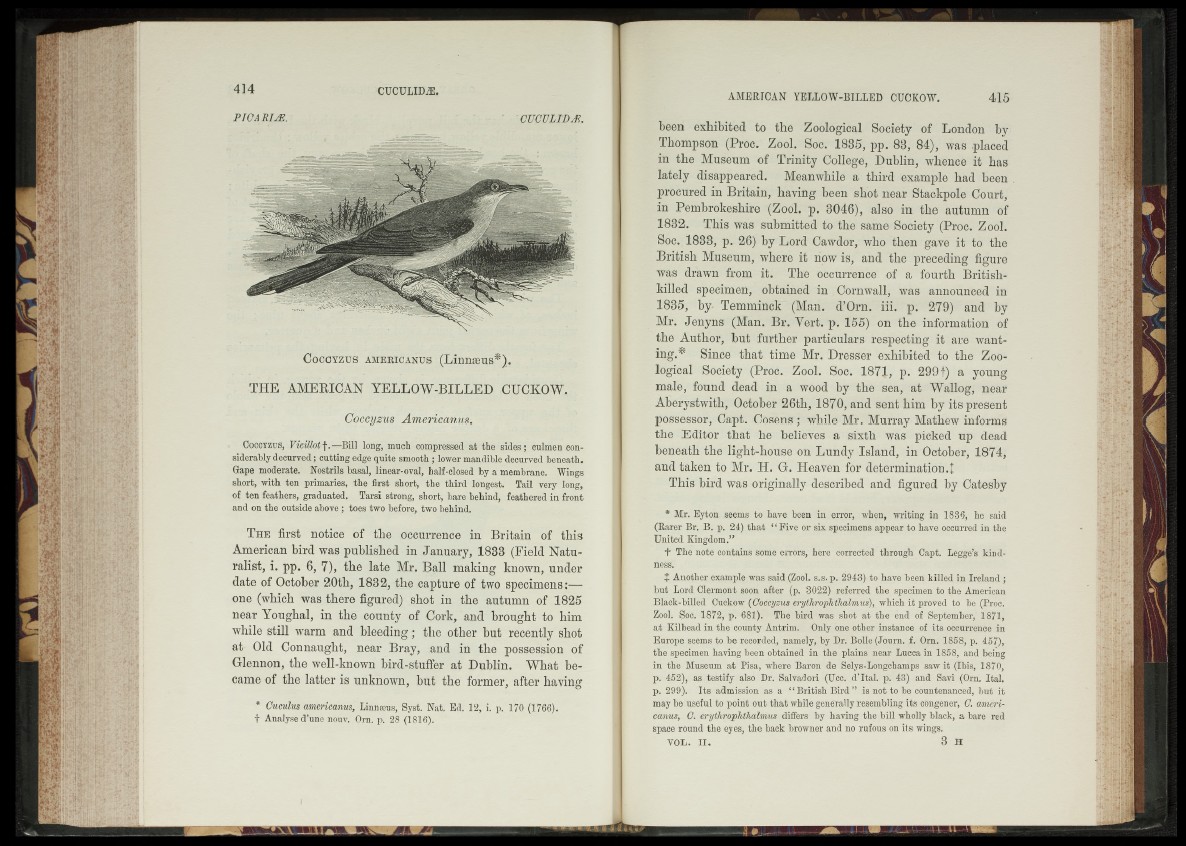
PTCA RIjE. . ' | CUCULIDJR.
C ocoyzus Americanus (Linnaeus*).
THE AMERICAN YELLOW-BILLED CUCKOW.
Coccyzus Americanus.
Cocoyzus, V i e i U o t long, much compressed at the sides; culmen considerably
decurved; cutting edge quite smooth; lower mandible decurved beneath.
Gape moderate. Nostrils basal, linear-oval, half-closed by a membrane. Wings
short, with ten primaries, the first short, the third longest. Tail very long,
of ten feathers, graduated. Tarsi strong, short, bare behind, feathered in front
and on the outside above ; toes two before, two behind.
T h e first notice of the occurrence in Britain of this
American bird was published in January, 1833 (Field Naturalist,
i. pp. 6, 7), the late Mr. Ball making known, under
date of October 20th, 1832, the capture of two specimens:—
one (which was there figured) shot in the autumn of 1825
near Youghal, in the county of Cork, and brought to him
while still warm and bleeding; the other hut recently shot
at Old Connaught, near Bray, and in the possession of
Glennon, the well-known bird-stuffer at Dublin. What became
of the latter is unknown, but the former, after having
* Cuculus americanus, Linnaeus, Syst. Nat. Ed. 12, i. p. 170 (1766).
f Analyse d’une nouv. Orn. p. 28 (1816).
AMERTCAN YELLOW-BILLED CUCKOW. 415
been exhibited to the Zoological Society of London by
Thompson (Proc. Zool. Soc. 1835, pp. 83, 84), was .placed
in the Museum of Trinity College, Dublin, whence it has
lately disappeared. Meanwhile a third example had been
procured in Britain, having been shot near Stackpole Court,
in Pembrokeshire (Zool. p. 3046), also in the autumn of
1832. This was submitted to the same Society (Proc. Zool.
Soc. 1833, p. 26) by Lord Cawdor, who then gave it to the
British Museum, where it now is, and the preceding figure
was drawn from it. The occurrence of a fourth British-
killed specimen, obtained in Cornwall, was announced in
1835, by- Temminck (Man. d’Orn. iii. p. 279) and by
Mr. Jenyns (Man. Br. Yert. p. 155) on the information of
the Author, but further particulars respecting it are wanting.*
Since that time Mr. Dresser exhibited to the Zoological
Society (Proc. Zool. Soc. 1871, p- 2991) a young
male, found dead in a wood by the sea, at Wallog, near
Aberystwith, October 26th, 1870, and sent him by its present
possessor, Capt. Cosens ; while Mr. Murray Mathew informs
the Editor that he believes a sixth was picked up dead
beneath the light-house on Lundy Island, in October, 1874,
and taken to Mr. H. G. Heaven for determination.!
This bird was originally described and figured by Catesby
* Mr. Eyton seems to have been in error, when, writing in 1836, he said
(Rarer Br. B. p. 24) that “ Five or six specimens appear to have occurred in the
United Kingdom.”
f The note contains some errors, here corrected through Capt. Legge’s kindness.
J Another example was said (Zool. s.s. p. 2943) to have been killed in Ireland ;
but Lord Clermont soon after (p. 3022) referred the specimen to the American
Black-billed Cuckow (Coccyzus erythrophthalmus), which it proved to be (Proc.
Zool. Soc. 1872, p. 681). The bird was shot at the end of September, 1871,
at Kilbead in the county Antrim. Only one other instance of its occurrence in
Europe seems to be recorded, namely, by Dr. Bolle (Journ. f. Om. 1858, p. 457),
the specimen having been obtained in the plains near Lucca in 1858, and being
in the Museum at Pisa, where Baron de Selys-Longchamps saw it (Ibis, 1870,
p. 452), as testify also Dr. Salvadori (Ucc. d'ltal. p. 43) and Savi (Orn. Ital.
p. 299). Its admission as a “ British Bird” is not to be countenanced, but it
may be useful to point out that while generally resembling its congener, C. americanus,
C. erythrophthalmus differs by having the bill wholly black, a bare red
space round the eyes, the back browner and no rufous on its wings.
VOL. II. 3 H